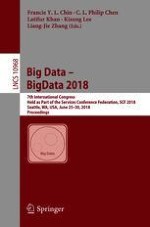2018 | Book
Big Data – BigData 2018
7th International Congress, Held as Part of the Services Conference Federation, SCF 2018, Seattle, WA, USA, June 25–30, 2018, Proceedings
Editors: Francis Y. L. Chin, Prof. C. L. Philip Chen, Dr. Latifur Khan, Prof. Kisung Lee, Liang-Jie Zhang
Publisher: Springer International Publishing
Book Series : Lecture Notes in Computer Science
